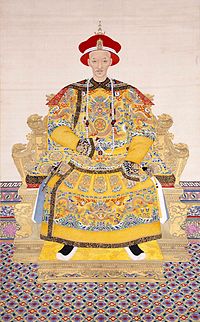
Back دائو قوآنق (ایمپیراتور) AZB Emperador Daoguang BCL Міньнін Byelorussian ཏའོ་ཀྭང་། (གོང་མ།) Tibetan Daoguang Catalan Dô̤-guŏng Huòng-dá̤ CDO Tao-kuang Czech Daoguang German Daoguang Spanish Daoguang Basque
| Daoguang Emperor 道光帝 | |||||||||||||||||
|---|---|---|---|---|---|---|---|---|---|---|---|---|---|---|---|---|---|
 | |||||||||||||||||
| Emperor of the Qing dynasty | |||||||||||||||||
| Reign | 3 October 1820 – 26 February 1850 | ||||||||||||||||
| Predecessor | Jiaqing Emperor | ||||||||||||||||
| Successor | Xianfeng Emperor | ||||||||||||||||
| Prince Zhi of the First Rank | |||||||||||||||||
| Tenure | 1813 – 3 October 1820 | ||||||||||||||||
| Born | 16 September 1782 (乾隆四十七年 八月 十日) Xiefang Hall, Forbidden City, Beijing | ||||||||||||||||
| Died | 26 February 1850 (aged 67) (道光三十年 正月 十五日) Imperial Gardens, Beijing | ||||||||||||||||
| Burial | Mu Mausoleum, Western Qing tombs | ||||||||||||||||
| Consorts | |||||||||||||||||
| Issue |
| ||||||||||||||||
| |||||||||||||||||
| House | Aisin-Gioro | ||||||||||||||||
| Dynasty | Qing | ||||||||||||||||
| Father | Jiaqing Emperor | ||||||||||||||||
| Mother | Empress Xiaoshurui | ||||||||||||||||
| Daoguang Emperor | |||||||||||
|---|---|---|---|---|---|---|---|---|---|---|---|
| Chinese | 道光帝 | ||||||||||
| |||||||||||
The Daoguang Emperor (16 September 1782 – 26 February 1850), also known by his temple name Emperor Xuanzong of Qing, personal name Mianning, was the eighth emperor of the Qing dynasty, and the sixth Qing emperor to rule over China proper. His reign was marked by "external disaster and internal rebellion". These include the First Opium War and the beginning of the Taiping Rebellion which nearly brought down the dynasty. The historian Jonathan Spence characterizes the Daoguang Emperor as a "well meaning but ineffective man" who promoted officials who "presented a purist view even if they had nothing to say about the domestic and foreign problems surrounding the dynasty".[1]
- ^ Spence 1990, pp. 149, 166.